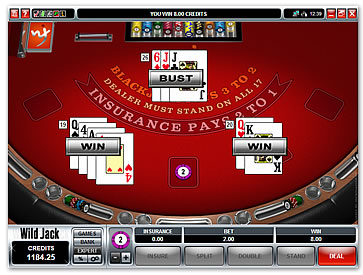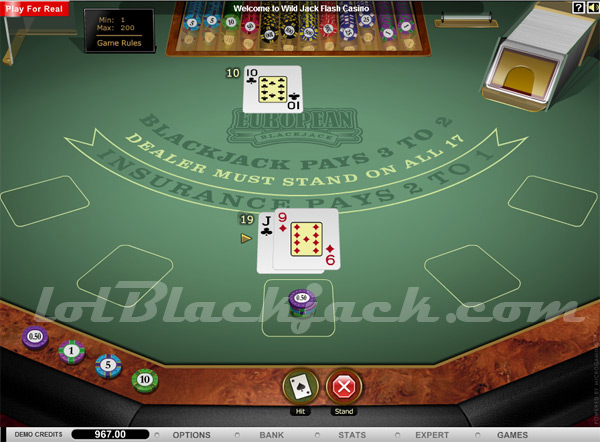Blackjack Probability Odds
Blackjack odds are percentage figures which represent your probability of losing or winning a hand. They can also represent the house edge or their profit margins as well. Usually probability odds don't mean much on the short term, but they clearly average out in the long term and this is why the casinos always win over the long term.
We decided to make a few tables and charts of the most common blackjack probability odds for various scenarios and situations found while playing blackjack. The most important odds percentage represents the dealer's edge in the game. This is the long term advantage that they have which will eventually take your money away. Blackjack is actually one of the most popular games in the casino and also has some of the lowest odds of all the casino games, except casino craps of course. Generally their edge ranges from 1% to 15% depending on what variation of blackjack you are playing.
How to Beat the Casino House Odds
There is one feature that makes blackjack more desirable than any other casino game. There is actually a way to beat the house edge by increasing your odds. In fact, your probability odds in blackjack can be increase to the point where you would actually be making the profit in the long term, essentially turning the casino into a personal ATM. This practice is known as card counting and casinos don't like this because they know they will be losing money.
Before you start card counting, you should learn "blackjack basic strategy", which is the mathematically correct way to play every move in blackjack to get the best odds. This can lower the house edge to less than 1 percent. When that percentage goes to a negative number such as -1%, then it is you who has the edge over the casino. This is when you complement basic strategy with card counting to get the highest efficiencies.
Odds vs. Dealer Up Card
The first odds chart shows what kind of advantage the player has vs. the dealer based on what his up card is showing. The first column in the chart is what card the dealer has showing after the cards have been dealt. The second column of the table shows the dealer's probability of going bust based on each card. The last column shows the advantage the player has and the probability of winning based on the basic strategy theory. As you can see, the dealer has about a 43% chance of going bust when he has a 5 showing as an up card. At the same time, the player has about 23% advantage as well. Notice that the player advantage goes negative when the 10 cards and ace start showing up. This means the player is more likely to lose.
| Dealer's Up Card | Dealer Odds of Busting | Player Advantage Percentage |
|---|---|---|
| 2 | 35.30% | 9.8% |
| 3 | 37.56% | 13.4% |
| 4 | 40.28% | 18.0% |
| 5 | 42.89% | 23.2% |
| 6 | 42.08% | 23.9% |
| 7 | 25.99% | 14.3% |
| 8 | 23.86% | 5.4% |
| 9 | 23.34% | -4.3% |
| 10 | 21.43% | -16.9% |
| J | 21.43% | -16.9% |
| Q | 21.43% | -16.9% |
| K | 21.43% | -16.9% |
| A | 11.65% | -16.0% |
Blackjack odds of Busting While Taking a Hit
This chart shows the probabilities of going bust after taking a hit. Busting means that your card total would go over 21 points and would be a hard total as well. The highest score you can get when being initially dealt two cards is 21 points so you can never go bust. This means if you took a hit on a hard 21, you would have a 100% probablity of going bust, which is common sense. Also, if you have 11 points or less, it is impossible to go over 21 points on the next hit and your odds of going bust would be 0 percent.
| Total Hand Value | Probability of Going Bust |
|---|---|
| 21 | 100% |
| 20 | 92% |
| 19 | 85% |
| 18 | 77% |
| 17 | 69% |
| 16 | 62% |
| 15 | 58% |
| 14 | 56% |
| 13 | 39% |
| 12 | 31% |
| 11 or less | 0% |
House Advantage with Multiple Number of Decks
The number of 52 card decks in a game of blackjack influences the house edge. In some cases, the odds increase in favor of the casino when more decks are used. The advantage edge can be as much as 1% towards the casino and this is a big number in terms of odds over the long term. As you can see here, a single deck of card gives the lowest edge for the casino and gives the player better odds. Multiple decks such as eight decks increases the house edge almost 18 times more than it would for the single deck!
| Number of Decks | House Odds Advantage |
|---|---|
| Single Deck | 0.04% |
| Double Deck | 0.42% |
| Four Decks | 0.61% |
| Six Decks | 0.67% |
| Eight Decks | 0.70% |
Two Card Frequency Odds
The next odds table deals with the first two cards being dealt or the 2 card frequency odds. Every player is dealt two cards at the beginning of a round of blackjack so this chart tells you the percentage of getting different categories of hands. A natural blackjack is only 4.8%, which essentially is an ace dealt with a ten card straight off the initial deal. Normally the odds are 3 to 2 and you would win $3 for every $2 wagered. It's a small percentage but it's the most desirable hand to get. The lowest hand you can get is two points (two aces). This is part of the decision hands group where players are usually dealt soft hands and can make decisions without going bust. This group is the most common.
The other category is the hard standing hands. These hands are somewhat desirable because of the high scores likely to beat the dealer. These are the second most frequent two card blackjack hands. Finally there is a no bust two card hand. No bust means any two card hand that won't bust on the next hit, such as any soft hand or hard hand that is 11 points or less.
| Two Card Combination | Frequency Percentage |
|---|---|
| Natural 21 Blackjack | 4.8% |
| Hard Standing (17 - 20) | 30.0% |
| Decision Hands (2-16) | 38.7% |
| No Bust | 26.5% |
| Total (all two card hands) | 100% |
Probability Edge for Each Card Removed from Deck
The next table shows how much your odds improve after when certain cards have been dealt and removed from the deck. Certain cards taken out of the deck and increase or decrease your blackjack odds percentage and the house edge.
This is very important for card counting. If you want the absolute perfect odds in card counting, you have to acount for each small change in the odds whenever a card is dealt. As you can see from the table, when small cards are taken out of play, the odds increase in your favor overall. This is a paramount property of card counting. The opposite happens when large cards are dealt. Your odds begin to decrease. When you are counting cards, you will notice your count decreasing when large cards are dealt.
You can imagine how complicated it would be to be adding these numbers in your head while card counting at the same time. If your mind was a computer, it would be easier to keep track of the percentage. Some people can do this, and this is the way to become a perfect card counter! It is easier to keep track of the odds when playing with a single blackjack deck. For example, when five cards are seen on the table, they offer a 0.67% increase in your advantage. In fact, when a lot of fives are used up, your odds will be much higher than if any of the other low cards were used up, even the six point cards. Also, these effects are cumulative so you always need to keep track of the odds after every card is dealt. This data is actually quite amazing!
| Removed Card | Effect on Odds |
|---|---|
| 2 | 0.40% |
| 3 | 0.43% |
| 4 | 0.52% |
| 5 | 0.67% |
| 6 | 0.45% |
| 7 | 0.30% |
| 8 | 0.01% |
| 9 | -0.15% |
| 10 | -0.51% |
| Jack | -0.51% |
| Queen | -0.51% |
| King | -0.51% |
| Ace | -0.59% |
Dealer Final Hand Probability Odds
This next table shows the odds of what the dealer's final hand will be. Usually in blackjack, the dealer must hit on 16 and stand on 17. These rules are slightly different for other variations of twenty-one. So generally, the odds of the dealer's final score being 16 are 0% because he must hit. This table will show the probability of the dealer busting or getting a non-bust hand as well as natural blackjacks.
| Dealer Final Hand | Probability of Getting Final Hand |
|---|---|
| Natural Blackjack | 4.82% |
| 21 (more than 2 cards) | 7.36% |
| 20 | 17.58% |
| 19 | 13.48% |
| 18 | 13.81% |
| 17 | 14.58% |
| Non-Bust (less than 21) | 71.63% |
| Bust (more than 21) | 28.37% |


 US Players and Credit Card Deposits Accepted!
US Players and Credit Card Deposits Accepted!





